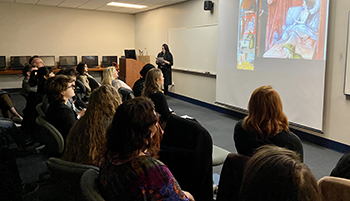It’s Elementary: The Bayeux Tapestry as a Medieval Educational Tool
Description/Abstract/Artist Statement
The Bayeux Tapestry has baffled historians resulting in diverse scholarship since its rediscovery in the eighteenth century. Long-standing assumptions about the Bayeux Tapestry’s commission, production, and purpose have accumulated through the years based on a single inventory document from 1476 which postulates its intended location and function as a religious ornament for Bayeux Cathedral, leading many scholars to assume the patron had been Odo, Bishop of Bayeux.[i] Scholars have gleaned from the Tapestry’s diverse scenes features of Anglo-Norman life which have been explored by modern academics attempting to interpret them, but a relationship between the Bayeux Tapestry and its utility in Anglo-Norman England cannot yet be accurately constructed. Due to the lack of contemporary documents relative to the Tapestry, the approach taken by scholars in an effort to retell its story remains fixed in the idea that the Bishop of Bayeux commissioned it to serve as an ecclesiastical decoration. Thus, room for new ideas regarding the nature of the Bayeux Tapestry have been stifled. Through comprehensive examinations of medieval noblewomen’s prominent roles in society, Anglo-Saxon traditions in education, and the functions of fables and humor as depicted in the embroidery friezes, the Bayeux Tapestry is revealed as indisputably a didactic tool for eleventh-century Anglo-Norman education, thus constructing a new narrative for the Tapestry as undeniably instructive rather than decorative.
[i] Howard R. Bloch, A Needle in the Right Hand of God: The Norman Conquest of 1066 and the Making and Meaning of the Bayeux Tapestry (New York: Random House, 2006), 32.
Faculty Advisor/Mentor
Anne Muraoka
Presentation Type
Oral Presentation
Disciplines
Ancient, Medieval, Renaissance and Baroque Art and Architecture
Session Title
College of Arts & Letters 5
Location
Learning Commons @ Perry Library Room 1306
Start Date
2-8-2020 11:30 AM
End Date
2-8-2020 12:30 PM
It’s Elementary: The Bayeux Tapestry as a Medieval Educational Tool
Learning Commons @ Perry Library Room 1306
The Bayeux Tapestry has baffled historians resulting in diverse scholarship since its rediscovery in the eighteenth century. Long-standing assumptions about the Bayeux Tapestry’s commission, production, and purpose have accumulated through the years based on a single inventory document from 1476 which postulates its intended location and function as a religious ornament for Bayeux Cathedral, leading many scholars to assume the patron had been Odo, Bishop of Bayeux.[i] Scholars have gleaned from the Tapestry’s diverse scenes features of Anglo-Norman life which have been explored by modern academics attempting to interpret them, but a relationship between the Bayeux Tapestry and its utility in Anglo-Norman England cannot yet be accurately constructed. Due to the lack of contemporary documents relative to the Tapestry, the approach taken by scholars in an effort to retell its story remains fixed in the idea that the Bishop of Bayeux commissioned it to serve as an ecclesiastical decoration. Thus, room for new ideas regarding the nature of the Bayeux Tapestry have been stifled. Through comprehensive examinations of medieval noblewomen’s prominent roles in society, Anglo-Saxon traditions in education, and the functions of fables and humor as depicted in the embroidery friezes, the Bayeux Tapestry is revealed as indisputably a didactic tool for eleventh-century Anglo-Norman education, thus constructing a new narrative for the Tapestry as undeniably instructive rather than decorative.
[i] Howard R. Bloch, A Needle in the Right Hand of God: The Norman Conquest of 1066 and the Making and Meaning of the Bayeux Tapestry (New York: Random House, 2006), 32.


